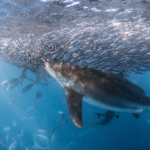Article courtesy of news.nationalgeographic.com | Karen de Seve | Please click here for original article.
![]()
Above: Divers follow a whale shark in the Gulf of Mexico. Photograph by Pablo Cersosimo, Robert Harding / Corbis.
Whale sharks are generally thought of as denizens of the tropical waters of the Gulf of Mexico or the warm waters of the Indian Ocean. But in July 2014, a person in New Jersey saw a whale shark and reported it to Wildbook for Whale Sharks, which collects reports, pictures, and video of animals that people encounter on their travels.
This surprised Jason Holmberg, information architect for Wild Me, the platform behind Wildbook for Whale Sharks.
“We had no idea [whale sharks] went that far north, [and] there were no pictures to confirm it.” Then Holmberg found a corroborating video of the same big fish off Sandy Hook, New Jersey, on YouTube.
That’s just one example of how enlisting input from a network of volunteer citizen scientists expands the reach of a project, sometimes beyond what scientists can imagine.
The ease of snapping and uploading pictures nowadays is great news for wildlife biologists, who rely on visual data to identify and track animals, whether it’s across the Serengeti, through the open ocean, or just in a suburban backyard.
Even with advanced technology like satellite tags and camera traps, experts still need help tracking elusive species on the move—and citizen science can fill in the gaps.
If the project is designed and managed well, non-expert data are accurate and viable: The Cornell Lab of Ornithology in Ithaca, New York, for example, successfully engages more than 200,000 crowd-science participants each year. (Also see “The Perils of Aging: A Problem for Citizen Science?”)
Colby Loucks, deputy director of the WWF’s Wildlife Conservation Program, said that “citizen science, or crowd science, is the way of the future. To not take advantage of the technology is to ignore a lot of potential data that would be too costly to pay a staff member to gather.”
Here are five outlets the general public can use to bolster wildlife research worldwide:
Wild Me
This site hosts user-friendly websites for anyone to upload sightings of wildlife. Those lucky enough to see the world’s biggest fish in person can report sightings at Wildbook for Whale Sharks. The same goes for manta rays at MantaMatcher. (Read about manta rays’ feeding frenzies.)
Behind the scenes, the Wild Me software plots the unique spots of animals to identify individuals. Images of the same animals seen in different locations, for instance, can tell scientists where the animals travel.
iNaturalist
This encyclopedic site is a gathering place for naturalists of all levels of expertise. Scientists can search the crowdsourced observations on iNaturalist for specific species and locations for their own research.
Also located under this umbrella site, National Geographic’s Great Nature Project allows people to upload their pictures to a global database of biodiversity, as well as “interact with other nature lovers by commenting and suggesting identifications for the amazing range of life you see.” (Also see National Geographic’s backyard bird identifier.)
Snapshot Serengeti
When scientists from the Serengeti Lion Project needed help cataloging millions of pictures from their 225 camera traps, they called upon the general public. (Explore National Geographic’s Serengeti lion interactive.)
Participants study images of African fauna in the project database and answer questions about the animals’ size, shape, and color that identify them for further research. So far, this animal-loving crowd has been accurate 96 percent of the time.
WildScan
Anyone who suspects an animal at a pet store or street market may have been illegally snatched from the wild can report it to authorities via this Android-only app.
Users can choose from menus to answer questions about size, shape, color, and species. They can also upload an image of the animal. Local authorities get alerted and can follow up on anything suspicious.
Bat Detective
Part of the vast Zooniverse family of crowd-science projects, this site combines listening to bat sounds from North America and looking at audio readouts to identify the types of bats that made the sounds. (See”Bats Make Calls to Jam Rivals’ Sonar-First Time Ever Found.”)
As more bat calls are identified, researchers can fine-tune computer programs to help monitor the thousands of bat species that use these calls.
So if you are going batty due to some down time or if you recently rediscovered a shoebox full of old vacation photos, hop online to join the crowd and help study wildlife.





